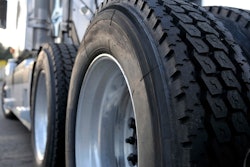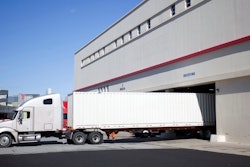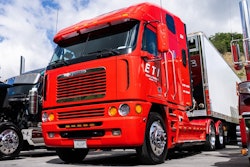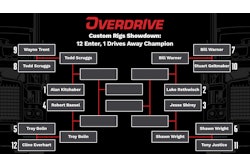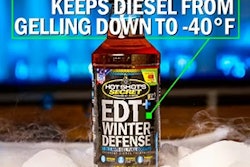Just as a truck with improperly geared rears will incur extra costs for its owner, so, too, will a truck with the wrong tires. Many more factors than size account for having the right tire for a specific truck in a specific application.
A tire dealer can make recommendations based on vehicle usage and tire characteristics such as price, fuel economy, durability, traction, miles to removal, retreadability and tread depth and pattern.
All play a role in proper spec’ing, and smart spec’ing can save money in two ways: reducing tire cost per mile and fuel cost per mile. Attributes that reduce one cost can have the opposite effect on the other cost, so tread carefully. That’s easier said than done at a time when specialization abounds.
Tire makers have moved over the years toward products that are designed to meet specific service needs. Since longer tire life means lower costs, the effort put into careful spec’ing will pay off well.
The four main tire applications are long haul, regional, on/off-road and urban. The different applications mean different tire lives, from as little as 20,000 miles for urban to more than 200,000 miles for a long-haul tire.
If you’re spec’ing a new truck, you can pick any tire size suitable to your application. A new truck’s drivetrain and engine controls are set according to the spec’d tire size. Replacement tires, however, may require drivetrain and engine adjustments. Changing tire sizes also might cause clearance issues.

[Related: Proper pressure -- key for tire, driver longevity and owner-ops' bottom lines]
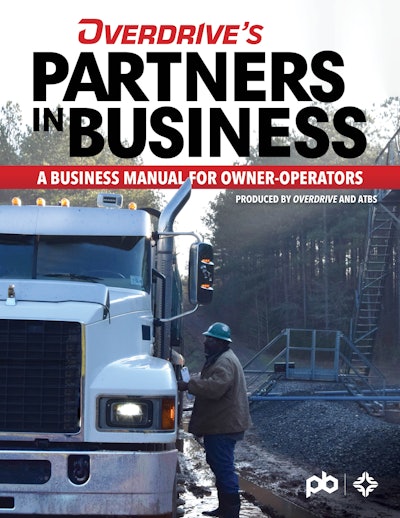 This feature is part of Overdrive's coproduction with business services firm ATBS of the Partners in Business manual, a comprehensive playbook for owner-operator careers. Browse the 2025 edition, in a dynamic online library format in eight sections, via this link.
This feature is part of Overdrive's coproduction with business services firm ATBS of the Partners in Business manual, a comprehensive playbook for owner-operator careers. Browse the 2025 edition, in a dynamic online library format in eight sections, via this link.
Some regional fleets have moved to long-haul steers for low rolling resistance rather than tires with more scrub resistance designed for regional operation. The tires may wear faster, but they save enough in fuel to more than cover the extra tire replacement costs.
Consider this common tractor-only scenario: The steers have a 125 rolling-resistance rating, the drives are at 137, and the truck gets 6 mpg. Replacing steers and drives with the lowest possible alternatives for RR rating (below 100) improves fuel economy to 6.52 mpg. While shallower tread depth equates to better fuel economy, it also usually means shorter tire life. The good news is tire manufacturers are using technology to counter this inherent tradeoff, using different compounding and silicate makeups to help enhance life.
Other smart tire spec’ing practices
Shop for the best value: Get the most for your money, whether you spend a little or a lot. It’s tempting to shop primarily by sticker price, but cost per mile and retreading potential are more important considerations. Making an informed choice means keeping written and dated records of purchase, fuel mileage and tread depth, then comparing records between models you’ve used. Consider warranty in any value calculation.
Go low-pro: For long-haul on-highway applications, a low-profile tire set-up with a shorter height than width offers advantages in fuel efficiency, handling, weight, overall truck height and tire life over more standard configurations. The aspect ratio -- sidewall height measured in a percentage relative to its width at its widest point -- of the most common 11R22.5 tires is about 100%, meaning the sidewall height and width are the same. Low-pro tires’ aspect ratio is about 80% with size designations such as 295/75R22.5.
Use wide singles: Wide singles weigh less and save fuel. One also costs less than the two tires they’re designed to replace, although you have to buy new rims to get in the game. Wide singles are retreadable, too. With a fuel-efficiency gain of 4% due to the reduced rolling resistance singles offer, though, the yearly fuel savings will pay for the new wheels and tires in just a couple of years. If you’re in a payload-sensitive application, the weight savings could yield bigger revenue, reducing that time period dramatically.
An automatic tire inflation system can address the most common complaint about wide singles, inability to “limp” to the next service site with a flat, by keeping tires inflated to proper pressure.
Use retreads: Premium tire makers design casings for retread use. New tires today can be retreaded up to four times after their initial tread life ends, and many an owner-operator has built a retreading program with a trusted tire servicer to retread his or her own virgin casings at regular service intervals. The cost of a retread tire is half that of a new tire -- or in some cases even less than half. On the downside, some carriers and state governments restrict retread use on steer axles. And not all retreads are created equal. If the retread isn’t from a reputable dealer, or if its markings have been scrubbed off the side, think twice before buying.
A common practice is to buy new steer tires, place the first retread on the drive and the second on the trailer. Trailer owners have more potential for retreading because of options for repositioning tires.
Casings that are rated higher -- with fewer repairs and lower heat history -- tend to be placed on the drive axle since the torque on those tires leads to higher heat generation.
[Related: Long live your tires: Proper maintenance and retreading]
Understanding tread by position
Tire choices are about compromise, particularly when it comes to spec’ing the right tread. In general, steer tires are usually rib-type tires with medium tread depth, while drive tires, when traction on snow or mud might be a factor, tend to be more aggressive with cross grooves (lugs) and deeper tread depths.
If a truck hauls over the road but never leaves Florida highways, it would benefit, in both wear rate and fuel economy, from using rib tires on every wheel position.
Steer
- Four or five straight solid ribs support lateral forces created during normal handling and cornering and by wind drag.
- Tread pattern design and tread compound resists irregular wear in long/medium-haul service or is cut- and chip-resistant for on/off-road service.
- Tread depth delivers long tread life while offering low rolling resistance for greater fuel efficiency.
Drive
- Tread pattern designed with closed shoulder (shoulder ribs) for long-haul service to prevent irregular wear and provide good handling.
- Tread pattern designed with open shoulder (shoulder lugs) for regional operation, offering secure traction. Blocks in the central tread for all.
- Deep tread for long tread life, but a low-rolling-resistance compound for fuel economy.
Trailer
- Shallow tread delivers longer life and guards against irregular wear.
- Strong solid shoulders for strong dragging forces and scrub.
- Special compound reduces rolling resistance.
- Trailer tires are a valuable position for fuel-saving tires and can contribute upwards of 40% of a truck’s tire rolling resistance.
Read next: Good habits behind the wheel and in the shop key to long tire life



